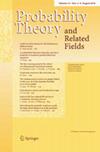正则结构中的模型特征:准线性案例
IF 1.6
1区 数学
Q2 STATISTICS & PROBABILITY
引用次数: 0
摘要
我们给出了正则性结构中居中模型的新特征,这种正则性结构在粗糙驱动力消失时仍然存在。我们针对一类由噪声驱动的准线性方程提出了我们的结果,但我们相信该方法是稳健的,适用于更广泛的亚临界方程。此外,我们还证明,噪声集合的收敛序列在统一满足谱间隙假设的情况下,意味着相关模型的相应收敛。结合特征描述,这就建立了一个普遍性类型的结果。本文章由计算机程序翻译,如有差异,请以英文原文为准。

Characterizing models in regularity structures: a quasilinear case
We give a novel characterization of the centered model in regularity structures which persists for rough drivers even as a mollification fades away. We present our result for a class of quasilinear equations driven by noise, however we believe that the method is robust and applies to a much broader class of subcritical equations. Furthermore, we prove that a convergent sequence of noise ensembles, satisfying uniformly a spectral gap assumption, implies the corresponding convergence of the associated models. Combined with the characterization, this establishes a universality-type result.
求助全文
通过发布文献求助,成功后即可免费获取论文全文。
去求助
来源期刊

Probability Theory and Related Fields
数学-统计学与概率论
CiteScore
3.70
自引率
5.00%
发文量
71
审稿时长
6-12 weeks
期刊介绍:
Probability Theory and Related Fields publishes research papers in modern probability theory and its various fields of application. Thus, subjects of interest include: mathematical statistical physics, mathematical statistics, mathematical biology, theoretical computer science, and applications of probability theory to other areas of mathematics such as combinatorics, analysis, ergodic theory and geometry. Survey papers on emerging areas of importance may be considered for publication. The main languages of publication are English, French and German.
 求助内容:
求助内容: 应助结果提醒方式:
应助结果提醒方式:


